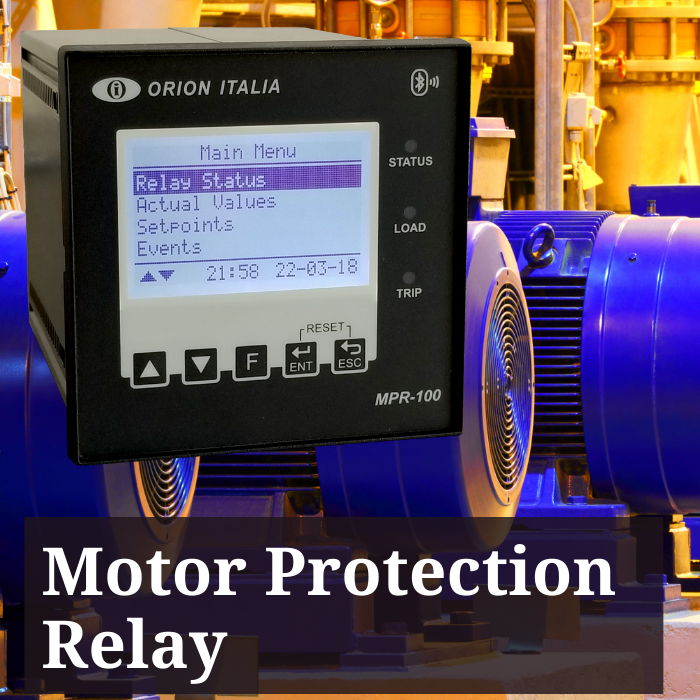Bảo vệ động cơ điện
Protection of electric motors
Thiết bị được trang bị các chức năng để đảm bảo ngắt kết nối động cơ khỏi lưới điện kịp thời khi phát hiện dấu hiệu bất thường trong quá trình làm việc, tránh hỏng hóc các bộ phận như cuộn dây, cách điện và kết nối điện.
Orion Italia đã lắp đặt hàng trăm nghìn bộ rắc le bảo vệ toàn cầu, xin vui lòng nhấp vào liên kết bên dưới để tìm hiểu thêm về sản phẩm giám sát và bảo vệ động cơ số MPR-100.
Vận hành động cơ điện
Trong quá trình vận hành động cơ điện, các biến đổi bất thường về chế độ hoạt động có thể xảy ra. Nguyên nhân phổ biến nhất dẫn tới tốc độ động cơ không phù hợp là quá tải, ngắn mạch, giảm hoặc mất điện áp. Quá tải được hiểu là lúc dòng điện của động cơ lớn hơn giá trị danh định. Quá tải có thể nhỏ và thoáng qua, điều này không gây nguy hiểm cho động cơ và không cần quan tâm khi bảo vệ. Tuy nhiên, nếu quá tải quá lớn và kéo dài sẽ làm hư hại cuộn dây do tản nhiệt lượng lớn từ dòng điện gây cháy cách điện và làm hỏng cuộn dây. Ngắn mạch trong cuộn dây cũng nguy hiểm cho động cơ. Bảo vệ động cơ khỏi quá tải và ngắn mạch được gọi là bảo vệ quá dòng. Phương pháp bảo vệ tối ưu sử dụng cầu chì, rắc le dòng điện và rắc le nhiệt. Loại thiết bị bảo vệ phụ thuộc vào công suất, loại động cơ, điều kiện khởi động và tính chất quá tải.
Nhấp vào bên dưới để biết thêm thông tin về:
- Cảm biến nhiệt độ Pt100 cho cuộn dây động cơ
- Giải pháp hoàn chỉnh (Pt100, Rơle bảo vệ nhiệt độ động cơ)
- Hộp công nghiệp sẵn có các thiết bị đầu cuối và hệ thống dây điện cho cảm biến Pt100
Yêu cầu bảo vệ động cơ điện
In every motor branch circuit there must be some minimum requirements for the protection of low voltage motors:
Trong mỗi mạch nhánh động cơ phải có một số yêu cầu tối thiểu để bảo vệ động cơ điện áp thấp:
Phân chia. Nó được cung cấp bởi một thiết bị có khả năng mở mạch với chỉ báo BẬT - TẮT trực quan. Mục đích là đảm bảo việc mở mạch nhánh một cách an toàn, bảo vệ người dùng và người vận hành.
Tự động bảo vệ ngắn mạch. Nó là một thiết bị tác động tức thời (từ tính hoặc điện tử) có khả năng phát hiện và cắt bất kỳ dòng điện nào lớn hơn dòng điện khởi động của động cơ, có thể gấp nhiều lần dòng điện danh định, tùy thuộc vào Chữ cái Mã của động cơ. Đây có thể là cầu chì, cuộn dây từ hoặc bảo vệ rơle điện tử được ghép nối với máy biến dòng.
Thiết bị điều động. Thông thường các công tắc tơ điện từ được sử dụng làm bộ khởi động hoặc khởi động mềm điện tử. Nó không thực sự là một biện pháp bảo vệ, mặc dù nó có thể chịu được dòng điện khởi động. Tuy là để điều khiển việc khởi động và dừng động cơ nhưng thực chất nó là thiết bị đóng, mở mạch nhánh của động cơ cả khi hoạt động bình thường và khi quá tải.
Bảo vệ quá tải. Thiết bị này được thiết kế để phát hiện dòng điện quá tải cao hơn dòng điện danh định; nhưng thấp hơn dòng điện ngắn mạch. Mặc dù nó cũng cảm nhận được dòng điện cao hơn nhưng hoạt động của nó bị trì hoãn và hoạt động không đủ nhanh để loại bỏ chúng. Điều này phải được thực hiện bằng cách bảo vệ ngắn mạch. Trong trường hợp này, rơle lưỡng kim, cầu chì trễ thời gian và rơle điện tử thường được sử dụng.
Rơle hoặc thiết bị điện tử đa chức năng
Các thiết bị thậm chí đã được phát triển có khả năng đáp ứng tất cả các yêu cầu của tiêu chuẩn cùng nhau. Chúng được gọi là bộ bảo vệ tích hợp hoặc bộ bảo vệ động cơ. Rơle hoặc thiết bị điện tử đa chức năng được sản xuất để bảo vệ động cơ. Những cái hiện đại nhất kết hợp các cổng giao tiếp nối tiếp để truyền kỹ thuật số tất cả dữ liệu của mạch động cơ nơi chúng được lắp đặt. Dữ liệu được gửi đến bộ vi xử lý hoặc máy tính để tạo ra các tín hiệu cảnh báo cần thiết và hành động khắc phục. Với loại rơle này, có thể phát hiện các tình trạng lỗi sau:
Maximum Temperature. Cách điện là phần dễ bị tổn thương nhất của động cơ. Người ta nói rằng tuổi thọ của động cơ có liên quan trực tiếp đến tuổi thọ của hệ thống cách điện của nó. Nếu không vượt quá nhiệt độ tối đa mà nó có thể chịu được, động cơ có thể hoạt động trong nhiều năm.
INSULATION CLASS
Since heat is the main cause for a motor to burn out, it seems logical that the most effective protection is precisely some device that allows detecting an increase in temperature around the winding. Eventual overheating and even more permanent overheating decrease the life of an engine. Bimetallic thermal relays constitute the simplest and most well-known system of thermal protection by indirect control, that is, by heating the motor through its consumption.
Phase Balance. When the systems voltage that supply a motor are out of balance, then positive sequence and negative sequence magnetic fields are formed in the stator that determine opposite torques on the rotor. In this condition the machine loses efficiency and the lost energy is transformed into a greater quantity of heat. This eventuality could be foreseen by means of devices that prevent the motor from working when the phase voltages are outside the preset range.
Single-Phasing. An extreme condition of phase unbalance occurs when any of the phases is missing from the three-phase system. The motor is then connected in a single phase but is unable to generate the torque necessary to overcome the mechanical load or to start. Then, in the induction machine, the operating point is moved towards the overload zone and to the same breaking point, stopping the rotor and remaining in operation under the locked rotor condition; that as we know, staying there is the closest condition to a short circuit.
For this condition, a device could be used that allows sensing the presence of the three phases and interrupting the operation when one of them is missing.
Rotation of the shaft. If the motor is energized but the shaft does not rotate, obviously it will be taking the starting current (LRA) from the network, which as we know can be several times the nominal current. The installation of a device that can detect the movement of the axis, will be a convenient protection.
Rotation speed. A complementary case of the previous protection is the rotation speed condition. Whether the shaft does not rotate or at a speed below the rated full load speed, the operating point drifts into the overload zone and can dangerously move into the break zone and is suddenly blocked. Even turning at low speed, fan cooling becomes ineffective and the winding temperature will increase dramatically.
Vibrations. Mechanical vibrations translate into shaft loads that displace the motor's nominal operating point, with the consequent increase in temperature. A system that allows sensing vibrations and inhibits engine operation under these conditions would be the most recommended protection.
No. of starts and stops. Continuous starts and stops increase the accumulated heat in the winding. There are counting devices that can prevent the motor from starting when a predetermined number of starts has been equalized in a given period of time.
Moisture in insulation. One of the polluting factors in insulation is humidity. In effect, the accumulation of humidity facilitates the leakage currents through the insulating material, exposing the motor to a ground fault condition, between phases or to a short circuit as the case may be.
When an engine is idle, its insulation system accumulates moisture; so the insulation resistance could get very low values. In some cases it would be enough to maintain a slight DC current that feeds the winding during non-operating periods; This would keep the winding slightly warm, preventing the accumulation of moisture.
There are relays that allow the incorporation of a continuous monitoring system of the insulation resistance of the motor when it is de-energized.
Ground fault. Ground fault is the most frequent condition that occurs due to loss of insulation in motors. Vibration, joule effect, friction, contamination and heat are the proximate cause in almost all winding ground fault cases. A ground fault relay may be the most suitable solution.
Insulation faults. Insulation faults degenerate into short circuits between turns of the same phase, to ground, between phases and three-phase. The latter is the most bloody and destructive of all.
Maximum locked rotor time. When the motor is energized, the rotor starts from the stopped condition to the rotating condition. This process should take a relatively short time until the rotor reaches rated speed, around 90% to 95% of synchronous speed. A device can be used that measures boot time and shuts down the system in the event that the preset boot time is exceeded. This condition should also be cleared by short circuit protection; only that it is adjusted above the RLA value, leaving the motor unprotected in a certain range.
Rotor lock while running. This is a special condition: the rotor was rotating normally and stops quickly. A similar problem could be caused by a sudden mechanical overload. In this case, it would be necessary to detect the rotation of the rotor and disconnect the supply in the event of an untimely stop.
Idle running. Idle running is manifested by overspeed. This occurs due to a sudden or sudden loss of mechanical load. This condition is critical in series type DC motors, since without load, the motor crashes and can be destroyed.
On the other hand, an induction motor that rotates at a speed very close to that of synchronism, remains outside the nominal operating point, being less efficient and therefore, releases energy in the form of heat.
For both cases, it would be convenient to detect the rotation speed and indicate the overspeed condition or loss of load.
Inversion of the direction of rotation. The direction of rotation in three-phase motors is determined by the sequence of the phases and in single-phase motors by the direction of the current in the starting winding as opposed to the running one. Some motors and their loads may be designed for this condition of reversal of the direction of rotation; others don't.
The direction of rotation is also reversed when the load exerts a drag torque much greater than the reactive torque of the motor. In this case, the rotor is dragged until it rotates backwards, which would be an extreme condition with respect to the current that the motor draws from the network.
Selection and adjustment of protection devices
The following recommendations are intended to guide users in the selection of the most appropriate protection devices for each case. The settings are the maximum settings allowed by the standards. It is clear that each case is a particular problem that must be solved with a more detailed study that must be carried out by a professional in the field.
Fuses
Application: Short Circuit Protection. Highly recommended in transformer protection and also as backup protections for other protection devices. In motors, a double element fuse can be used to provide a range of protection that includes the overload range. Selection: Based on the nominal current and also taking into account the Interrupting Capacity. Fit: They have no fit. The maximum value allowed by the standards is 300% of the nominal current. There are different types depending on their use and the expected operating time, and they can be slow, fast and ultra-fast among others.
Bimetallic Relays
Application: Widely used in overload protection (also named overcurrent) in low voltage motors. Selection: They are selected according to the nominal current of the motor at the working voltage. Adjustment: They can be adjusted between 80% and 125% of the rated motor current. The maximum setting value is 125% of the rated motor current. The recommendation is to adjust it to a lower value, allowing it to start normally. Interruption Capacity. It is the maximum Short Circuit current that the device can safely interrupt, without exploding.
Magnetic Switches
Application: Recommended for short circuit protection, especially in motors. Selection: Based on the value of the short-circuit current and the insulation damage curve. It is normally selected based on the maximum expected value of the starting current. Fit: Not all have fit. In case of having it, the recommendation is to adjust it to the minimum possible, as long as the starting of the engine is allowed. The maximum setting allowed by the standards is 700% of the rated current, depending on the Code Letter (*) and the Service Factor (**) of the motor.
Thermo-magnetic switches.
Application: Widely used in low voltage protections. They are useful in protecting general lighting loads, ovens, electrical outlets, etc. They are not as efficient in protecting motors because of the range of starting and overload currents. Selection: In consideration of the nominal current of the load and the short-circuit interrupting capacity. Fit: Not all have fit. Some of higher price, allow instantaneous tripping adjustments for protection in the range of short-circuit currents; more properly, in the range of starting currents. More modern and sophisticated versions, allow adjustments of both ranges. The maximum value of the short-circuit trip setting allowed by the standards is 700% of the rated current and the overload setting is 250% of the rated current.










